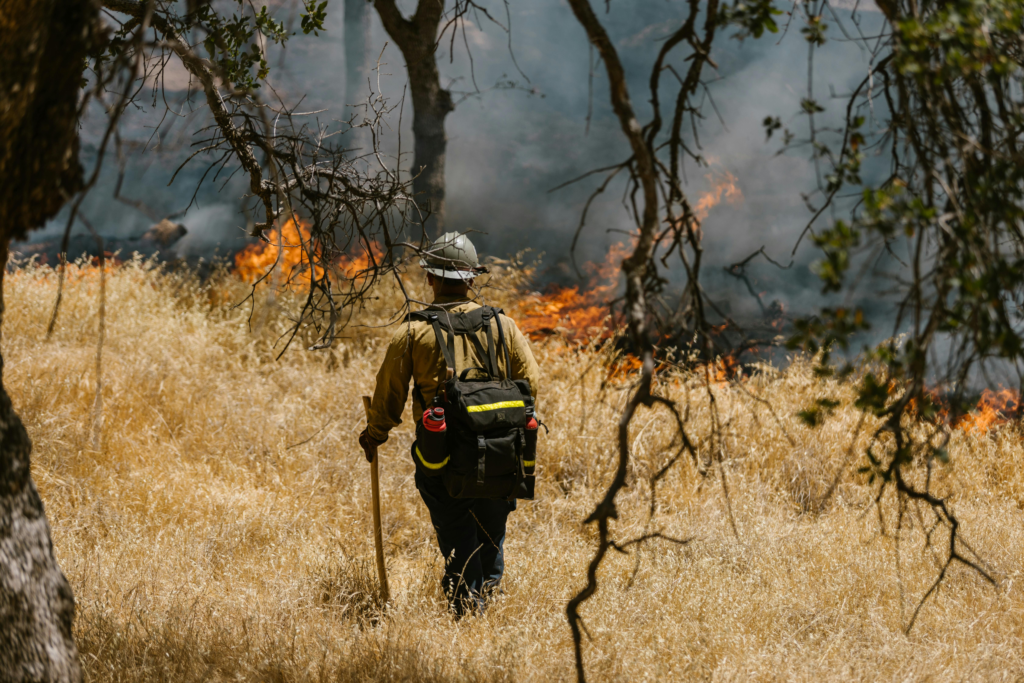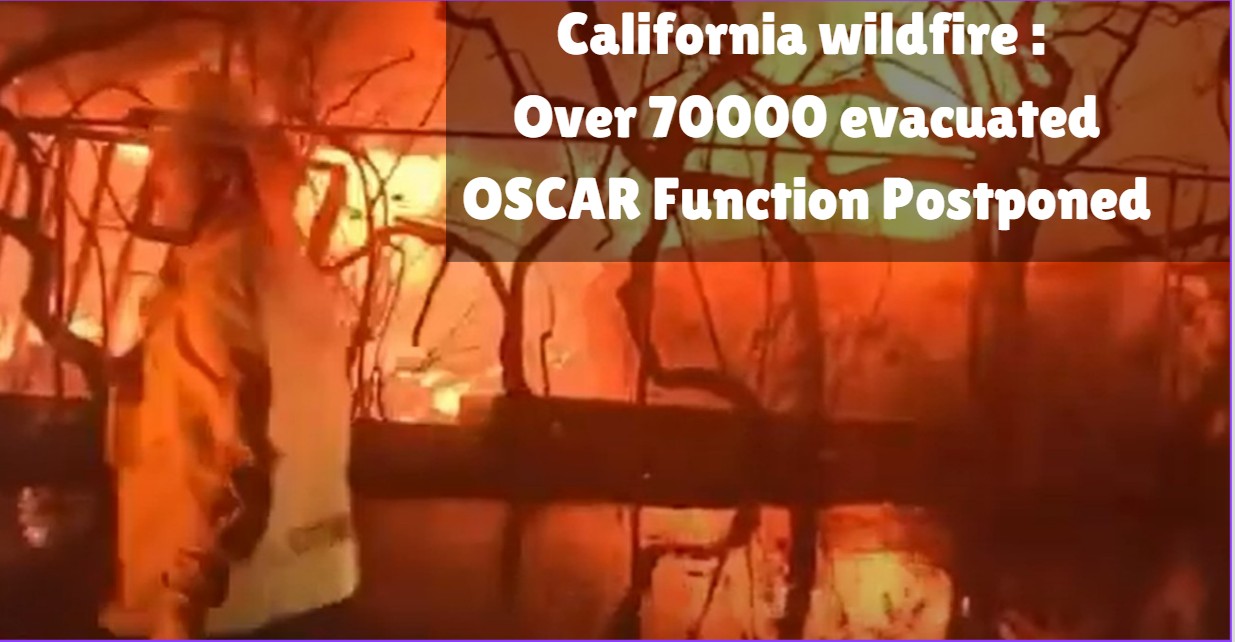कैलिफोर्निया में भीषण जंगल की आग का संकट है, क्योंकि लगातार लगी आग ने हजारों एकड़ जमीन को नष्ट कर दिया है, निवासियों को विस्थापित कर दिया है और अग्निशमन संसाधनों को चुनौती दी है। सबसे बड़ी आग, “गोल्डन ब्लेज़” ने 100,000 एकड़ से अधिक क्षेत्र को जला दिया है, जिसमें लोगों की जान चली…
California Wildfire कैलिफोर्निया जंगल की आग की आपात स्थिति: OSCAR स्थगित
California Wildfire कैलिफोर्निया हाल के इतिहास में अपनी सबसे गंभीर जंगल की आग की आपात स्थितियों में से एक का सामना कर रहा है। लगातार लगी आग ने पहले ही हजारों एकड़ जमीन को नष्ट कर दिया है, हजारों निवासियों को घर खाली करने के लिए मजबूर किया है और अग्निशमन संसाधनों को उनकी सीमा तक धकेल दिया है। सबसे बड़ी और सबसे विनाशकारी आग, जिसे “गोल्डन ब्लेज़” कहा जाता है, ने 100,000 एकड़ से अधिक क्षेत्र को जला दिया है। इसने लोगों की जान ले ली है, पूरे पड़ोस को राख में बदल दिया है और अरबों डॉलर का आर्थिक नुकसान पहुंचाया है।
California Wildfire कैलिफोर्निया के जंगल में लगी आग के संकट को समझना

फिलहाल, California Wildfire कैलिफोर्निया में कई जंगल में आग लगी हुई है। शास्ता, बट और प्लूमास सहित प्रमुख काउंटियों को खाली करने के आदेश दिए गए हैं। तेज़ हवाएँ, कम नमी और अत्यधिक गर्मी के कारण, आग के अनियंत्रित रूप से फैलने के लिए परिस्थितियाँ एकदम सही हैं। आपातकालीन सेवाओं ने कम से कम पाँच लोगों की मृत्यु और दर्जनों लोगों के घायल होने की सूचना दी है, साथ ही अस्पताल जलने, धुएँ में साँस लेने और आग से संबंधित अन्य चोटों के मामलों से भरे हुए हैं।
California Wildfire कैलिफोर्निया के जंगल में लगी आग के मूल कारण
कई कारक जंगल में लगी आग के संकट में योगदान करते हैं, जिससे यह गोल्डन स्टेट में एक आवर्ती आपदा बन जाती है:
जलवायु परिवर्तन: बढ़ते वैश्विक तापमान के कारण लंबे समय तक सूखा पड़ा है और जंगल में आग लगने का जोखिम बढ़ गया है। कैलिफोर्निया में जंगल में आग लगने का मौसम लंबा हो गया है, और गर्मियाँ समस्या को और बढ़ा रही हैं।
वन प्रबंधन के मुद्दे: दशकों से अपर्याप्त वन प्रबंधन के कारण सूखी वनस्पतियाँ जमा हो रही हैं, जिससे जंगल में आग लगने का खतरा बढ़ गया है।
मानवीय गतिविधियाँ: कई आग मानवीय कारणों से लगती हैं, जिनमें अनुचित तरीके से बुझाई गई कैम्पफ़ायर, बिजली की खराबी और जानबूझकर की गई आगजनी शामिल हैं।
California Wildfire कैलिफ़ोर्निया के जंगल में लगी आग से होने वाला मानवीय नुकसान
प्रभावित लोगों के लिए, जंगल की आग जीवन बदलने वाली रही है। हज़ारों लोगों ने अपने घर खो दिए हैं और पूरे समुदाय विस्थापित हो गए हैं। सबसे ज़्यादा प्रभावित क्षेत्रों में से एक की निवासी मारिया गोमेज़ ने अपनी आपबीती साझा की: “हमारे पास भागने से पहले अपनी ज़रूरत की चीज़ें लेने का भी समय नहीं था। आग को सब कुछ जलते हुए देखना दिल दहला देने वाला था।”
इस क्षेत्र में स्कूल और व्यवसाय बंद हैं और बिजली की लाइनें और पानी की सुविधाएँ जैसी महत्वपूर्ण अवसंरचनाएँ नष्ट हो गई हैं। आर्थिक प्रभाव चौंका देने वाले हैं, शुरुआती अनुमानों से पता चलता है कि कुल नुकसान $10 बिलियन से ज़्यादा हो सकता है।
पर्यावरणीय परिणाम
California Wildfire कैलिफ़ोर्निया के जंगल में लगी आग की आपात स्थिति में पर्यावरण पर होने वाला नुकसान भी उतना ही विनाशकारी है। हज़ारों एकड़ जंगल नष्ट हो गए हैं, साथ ही महत्वपूर्ण वन्यजीव आवास भी नष्ट हो गए हैं। जंगल की आग ने भारी मात्रा में कार्बन डाइऑक्साइड छोड़ा है, जिससे ग्लोबल वार्मिंग में और वृद्धि हुई है। इसके अलावा, आग से निकलने वाली राख और कालिख नदियों और झीलों को प्रदूषित कर रही है, जिससे लाखों लोगों के लिए पानी की आपूर्ति को खतरा है। California Wildfire
आर्थिक निहितार्थ
California Wildfire कैलिफ़ोर्निया की अर्थव्यवस्था भी प्रभावित हो रही है। राज्य की अर्थव्यवस्था की आधारशिला कृषि विशेष रूप से कमज़ोर है। फ़सलें जल गई हैं और खेतिहर मज़दूर विस्थापित हो गए हैं। बीमा उद्योग दावों में उछाल के लिए तैयार है, और पुनर्निर्माण प्रयासों में अरबों खर्च होने की उम्मीद है।
यह भी पढ़ें: महिंद्रा ने लॉन्च की जानलेवा ईवी कार
आपातकालीन प्रतिक्रिया
10,000 से ज़्यादा अग्निशामक विमान और भारी उपकरणों की मदद से आग बुझाने में लगे हैं। उनके अथक प्रयासों के बावजूद, अप्रत्याशित मौसम की स्थिति और आग के विशाल पैमाने के कारण नियंत्रण एक चुनौती बनी हुई है। गवर्नर गेविन न्यूज़ॉम ने आपातकाल की स्थिति घोषित कर दी है और संघीय सहायता की मांग की है। संघीय आपातकालीन प्रबंधन एजेंसी (FEMA) भी ज़मीन पर है और निकासी और राहत प्रयासों में सहायता के लिए संसाधन मुहैया करा रही है।
दीर्घकालिक समाधान
कैलिफ़ोर्निया के जंगल की आग के संकट को संबोधित करने के लिए, एक बहुआयामी दृष्टिकोण आवश्यक है:
बेहतर वन प्रबंधन: नियंत्रित जलाव को लागू करना और सूखी वनस्पति को हटाना आग के जोखिम को कम करने में मदद कर सकता है।
बुनियादी ढांचे का उन्नयन: बिजली लाइनों और विद्युत ग्रिडों का आधुनिकीकरण आकस्मिक आगजनी को रोक सकता है।
जलवायु कार्रवाई: जलवायु परिवर्तन से निपटने के लिए ग्रीनहाउस गैस उत्सर्जन को कम करने के लिए व्यापक नीतियाँ आवश्यक हैं।
सार्वजनिक शिक्षा: जागरूकता अभियान निवासियों को अग्नि सुरक्षा और तैयारियों को समझने में मदद कर सकते हैं।
आप कैसे मदद कर सकते हैं
संकट के समय में, समुदाय एक साथ आते हैं। यहाँ बताया गया है कि आप इस जंगल की आग की आपात स्थिति के दौरान कैलिफ़ोर्निया का समर्थन कैसे कर सकते हैं:
राहत प्रयासों के लिए दान करें: रेड क्रॉस, यूनाइटेड वे और स्थानीय अग्नि राहत निधि जैसे संगठन दान स्वीकार कर रहे हैं।
स्वयंसेवक: चाहे आभासी रूप से या साइट पर, विस्थापित परिवारों की सहायता करने और पुनर्प्राप्ति प्रयासों का समर्थन करने के लिए स्वयंसेवकों की आवश्यकता है।
जागरूकता फैलाएँ: कार्रवाई के आह्वान को बढ़ाने और विश्वसनीय दान प्लेटफार्मों के बारे में जानकारी साझा करने के लिए सोशल मीडिया का उपयोग करें।
आगे का रास्ता
कैलिफोर्निया की जंगल की आग की आपात स्थिति जलवायु परिवर्तन और पर्यावरण कुप्रबंधन से उत्पन्न चुनौतियों की एक स्पष्ट याद दिलाती है। जबकि राज्य के समुदायों की लचीलापन प्रेरणादायक है, भविष्य में ऐसी त्रासदियों को रोकने के लिए दीर्घकालिक समाधान आवश्यक हैं। मूल कारणों को संबोधित करना, संधारणीय प्रथाओं में निवेश करना और जिम्मेदारी की सामूहिक भावना को बढ़ावा देना एक सुरक्षित, अधिक सुरक्षित भविष्य सुनिश्चित करने की कुंजी होगी।
स्थानीय समाचार आउटलेट और आधिकारिक सरकारी अपडेट का पालन करके सूचित रहें। साथ मिलकर, हम इस संकट के माध्यम से कैलिफोर्निया का समर्थन कर सकते हैं और एक ऐसे भविष्य की दिशा में काम कर सकते हैं जहाँ ऐसी आपदाएँ कम बार-बार और कम विनाशकारी हों।


